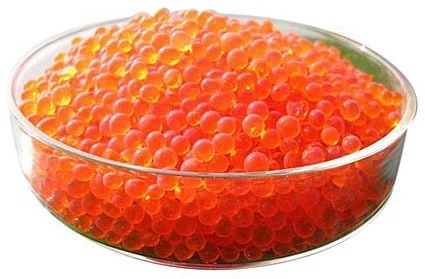Description
TECHNICAL SPECIFICATION
DESCRIPTIONS
SILICA GEL ORANGE BEADS Assay (as Si02)
98 %
4-6
Menitlg ponit
16100C
22300c
Bui Denysti m/tr
0.670 – 0.780
Density
Los on Drying %
4 – 6%
Los on Attrition
2.5 %Max
Adsorption Capacity at 10 %humidity35 -40%
Chloride (as Nacl)
Sulfates (as Na2S04)
Cobalt Chloride (as CaC12) Ammonium Compound (as NH3) Binder as CaSO4
Dimethyl Fumrate (DMF) Particle size
Colour Variation RH: 20%
RH: 35%
RH: 50%
Max. 0.5% pm Max 0.5 %pm 0.5 – 0.7 %
4-6
Orange Green Dark Green
Parameter Value
Particle Size 2-5 mm spherical beads
Adsorption Data
RH: 20% 9% Min.
RH: 50% 20 % Min.
RH: 90% 26% Min.
Loss on Drying 5% Max.
Colour Variation
RH: 20% Orange
RH: 35% Green.
RH: 50% Dark Green
Bulk Density (g/L) 700-800
Silica % 97-98
Loss on Drying (Max.) 37%
Silica Gel Orange packing 25 kg
Composition/Information of Ingredients Description
Dangerous Substance
Main Ingredient
CAS No.
UN-Identification No.(HS-Code)
Hazards Identification Health Rating: 2-Moderate Flammability Rating: 1-Slight Reactivity Rating: 1-Slight Contact Rating: 2-Moderate
Silica Gel Orange None
Si02, H20 7631-86-9 38249999.99
Ingestion:
No adverse effects expected
Skin Contact:
May cause irritation with dryness and abrasion Eye Contact:
May cause irritation, redness and pain Aggravation of Pre-existing Conditions:
No information found.
First-Aid Measures Inhalation:
Remove ot fresh air. Get medical attention for any breathing difficulty.
Ingestion:
Give several glasses of water to drink to dilute. fI large amounts were swallowed, get medical advice. Skin Contact:
Immediately flush skin with plenty of soap and water for at least 15 minutes. Remove contaminated clothing and shoes. Wash clothing before reuse. Thoroughly clean shoes before reuse. Get medical attention fi irritation develops.
Eye Contact:
Immediately flush eyes with plenty of water for at least 15 minutes, lifting upper and lower eyelids occasionally.
Date: 01.04.2022
Fire-Fighting Measures
Fire:
Not considered to be a fine hazard.
Explosion:
Not considered to be an explosion hazard.
Fire Extinguishing Media:
Use any means suitable for extinguishing surrounding fire.
Special Information:
Use protective clothing and breathing equipment appropriate for the surounding fire.
Accidental release measures
Personal precautions Respiratory protection, eye protection Methods for cleaning up Sweep the spil area, avoid rising dust
Handling and Storage
Keep ni a tightly closed container, stored ni a cool, dry, ventilated area. Protect against physical damage. When pouring into a container of flammable liquid, ground both containers electrically to prevent a static electric spark. Containers of this material may be hazardous when empty since they retain product residues(dust, solids); observe al warnings and precautions listed for the product.
Exposure Controls/Personal protection Airborne Exposure Limits: Silica(synthetic, amorphous):
-OSHA Permissible Exposure Limit(PEL)-
80/(%Si02)mg/m3(TWA) for amorphous silica, including natural diatomaceous earth.
Personal Respirators (NIOSHApproved):
fI the exposure limit si exceeded and engineering controls are not feasible, a half facepiece particulate respirator (NIOSH type N95 or better filters) may be worn for up ot ten times the exposure limit or the maximum use concentration specified by the appropriate regulatory agency or respirator supplier, whichever si lowest. Afull-face piece particulate respirator (NIOSH type N100 filters) may be worn up to 50 times the exposure limit, or the maximum use concentration specified by the appropriate regulatory agency, or respirator supplier, whichever si lowest. fI oil particles (e.g. lubricants, cutting fluids,
glycerine, etc.) are present, use aNIOSH type Ror Pfilter. For emergencies or instances where the exposure levels are not known, use a full-facepiece positive-pressure, air-supplied respirator. WARNING: Air-purifying respirators do not protect workers ni oxygen-deficient atmospheres.
Skin Protection:
Wear protective gloves and clean body-covering clothing.
Eye Protection:
Use chemical safety goggles. Maintain eye wash fountain and quick-drench facilities ni work area.
9. Physical and Chemical Properties
Appearance Orange, translucent liquid. Odor
odorless
Boiling point 100°C Melting point 0°С Freezing point С0°
Stability and Reactivity
Stability:
Stable under ordinary conditions of use and storage.
Hazardous Decomposition Products:
Oxides of carbon and silicon may be formed when heatedot decomposition.
Hazardous Polymerization:
Wil not occur.
Incompatibilities:
Reacts whti hydrogen fluoride, fluorine, oxygen difluride, chlorine trifluoride, strong acids, strong bases, and
oxidizers.
Conditions to Avoid:
Moisture, extreme heat, and incompatibles.
Regulatory information
Colloidal silica si not a dangerous substance according to US Federal regulations (Classification, Packaging and Labeling of Dangerous Substances) as last amended
Other information
The applicable regulations and industrial hygiene standards have to be considered
The data si based on the present state of knowledge and experience, without a claim being made for completeness.
The Safety Data Sheet serves to describe the product only with regard to the safety requirement. These data do not constitute a specification.





Reviews
There are no reviews yet.